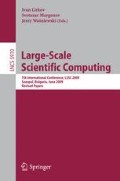Abstract
In the last ten years, there has been significant improvement and growth in tools that aid the development of finite element methods for solving partial differential equations. These tools assist the user in transforming a weak form of a differential equation into a computable solution. Despite these advancements, solving a differential equation remains challenging. Not only are there many possible weak forms for a particular problem, but the most accurate or most efficient form depends on the problem’s structure. Requiring a user to generate a weak form by hand creates a significant hurdle for someone who understands a model, but does not know how to solve it.
We present a new algorithm that finds the solution of a partial differential equation when modeled in its strong form. We accomplish this by applying a first order system least squares algorithm using triangular Bézier patches as our shape functions. After describing our algorithm, we validate our results by presenting a numerical example.
This research was financed by the Research Council of Norway through the SAGA-geo project.
Access this chapter
Tax calculation will be finalised at checkout
Purchases are for personal use only
Preview
Unable to display preview. Download preview PDF.
References
Awanou, G., Lai, M.J., Wenston, P.: The multivariate spline method for scattered data fitting and numerical solution of partial differential equations. In: Chen, G., Lai, M.J. (eds.) Wavelets and Splines: Athens 2005, pp. 24–74. Nashboro Press (2006)
Bangerth, W., Hartmann, R., Kanschat, G.: deal.II–a general purpose object-oriented finite element library. ACM Transactions on Mathematical Software 33(2) (August 2007)
Bochev, P.B., Gunzburger, M.D.: Finite element methods of least-squares type. SIAM Review 40(4), 789–837 (1998)
Bochev, P.B., Gunzburger, M.D.: Least-Squares: Finite Element Methods. Springer, Heidelberg (2009)
de Boor, C.: B-form basics. In: Farin, G. (ed.) Geometric Modeling: Algorithms and New Trends (1987)
Dular, P., Geuzaine, C., Henrotte, F., Legros, W.: A general environment for the treatment of discrete problems and its application to the finite element method. IEEE Transactions on Magnetics 34(5), 3395–3398 (1998)
Dupont, T., Hoffman, J., Johnson, C., Kirby, R., Larson, M., Logg, A., Scott, R.: The FEniCS project, PREPRINT 2003-21 (2003)
Farin, G.: Triangular Bernstein-Bézier patches. Computed Aided Geometric Design 3, 83–127 (1986)
Hecht, F., Pironneau, O., Hyaric, A.L., Ohtsuka, K.: Freefem++, 2nd edn., Version 2.24-2-2, www.freefem.org
Logg, A.: Automating the finite element method. Sixth Winter School in Computational Mathematics (March 2006)
Long, K.: Sundance 2.0 tutorial. Technical Report SAND2004-4793, Sandia National Laboratory (July 2004)
Prautzsch, H., Boehm, W., Paluszny, M.: Bézier and B-Spline Techniques. Springer, Heidelberg (2002)
Schumaker, L.L.: Computing bivariate splines in scattered data fitting and the finite-element method. Numerical Algorithms 48, 237–260 (2008)
Zheng, J., Sederberg, T.W., Johnson, R.W.: Least squares methods for solving differential equations using Bézier control points. Applied Numerical Mathematics (48), 237–252 (2004)
Author information
Authors and Affiliations
Editor information
Editors and Affiliations
Rights and permissions
Copyright information
© 2010 Springer-Verlag Berlin Heidelberg
About this paper
Cite this paper
Young, J. (2010). The Automatic Construction and Solution of a Partial Differential Equation from the Strong Form. In: Lirkov, I., Margenov, S., Waśniewski, J. (eds) Large-Scale Scientific Computing. LSSC 2009. Lecture Notes in Computer Science, vol 5910. Springer, Berlin, Heidelberg. https://doi.org/10.1007/978-3-642-12535-5_81
Download citation
DOI: https://doi.org/10.1007/978-3-642-12535-5_81
Publisher Name: Springer, Berlin, Heidelberg
Print ISBN: 978-3-642-12534-8
Online ISBN: 978-3-642-12535-5
eBook Packages: Computer ScienceComputer Science (R0)

